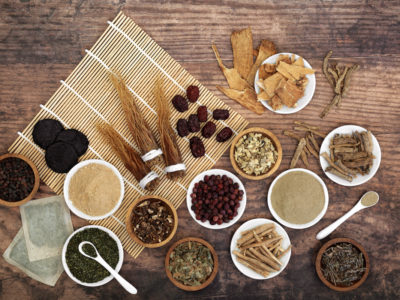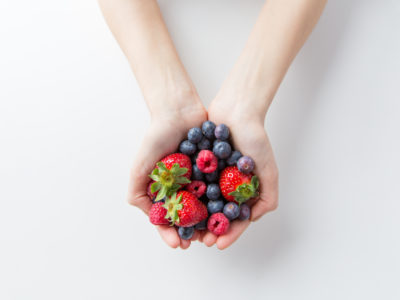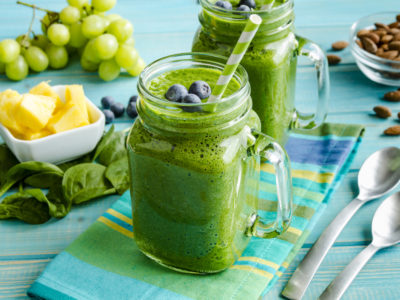Table of Contents[Hide][Show]
Do you feel like there’s a new “diet” or eating trend popping up every time you check the news?
There’s no question that there are many different ways to eat.
And once you become acquainted with them, you’ll probably start to notice a trend: Almost all of them are created to address the many shortcomings of the Standard American Diet (S.A.D.).
Because at this point, we know that almost anything is better than the highly-processed options most Western cultures choose to eat.
But here’s the thing: just because you’re trying to eat a less-processed diet doesn’t necessarily mean that it’s the optimal one for you.
Some diets might seem terrifically difficult or restrictive, and for many people, that’s a recipe for disaster. It’s hard to stay the course with a regimen you hate… And no one wants to eat in a way that makes them feel deprived of the things they love.
But today, we’re talking about eating foods that are alkaline.
So, where does a food plan based around alkalinity land?
The cool thing with this one is that this isn’t an “elimination” diet.
The focus is simply on what is good for you – which, by and large, is a balance of both alkaline and acidic foods.
There’s not a specific “eat this, don’t eat that” mentality when it comes to alkaline foods because we’re trying to serve the body’s best interest by adding things in, not necessarily restricting ourselves by cutting things out.
When you shift your mindset to look at all the great things you could be eating to serve your health better, then making healthier choices becomes a lot easier.
With that said, let’s dive into what alkaline foods are, why they’re great for you, and how you can incorporate them into your daily life.
What does “alkaline” mean?
Let’s get the science out of the way: what does it mean when something is alkaline?
In the general chemistry world, alkalinity refers to where something falls on the pH scale.
The pH scale refers to how acidic or basic (also called “alkaline”) a substance is.
The pH scale runs from 0 – 14, with the lower numbers referring to acids and the higher numbers referring to bases. The number 7 represents a neutral substance (most drinking water falls around neutral).
Every substance lands somewhere on this scale, but you probably don’t think much about it when you’re eating.
Once you get a general idea of how things feel in your body, how they taste, or how they smell – it becomes easier to guess whether something is more acidic or alkaline.
A general rule of thumb is that most acidic foods tend to have a sour taste to them. Alkaline foods don’t have a common “through” taste like this, but knowing that sour usually means acid is a great starting point.
But here’s where alkalinity becomes important: while certain acidic foods are great for health, our blood is naturally slightly alkaline.
The blood’s natural pH falls around 7.4, and this discovery created the theory for the alkaline diet.
Foods that disturb alkaline balance (& their effects on the body)
Knowing that the blood pH is slightly alkaline, health nuts and researchers started studying which foods are more acidic.
Some of the most common acidic foods include:
- Meat
- Grains
- Alcohol
- Dairy products
- Lentils
- Peanuts
- Soda
- Other highly processed foods
Related
15 Foods For Healthy Digestion
Back in the day when Jamie Lee Curtis was lighting up the big screen in movies like True Lies, we probably didn’t anticipate her becoming the face of one of the most heavily pushed products on TV today: probiotics. But being synonymous with a branded yogurt that promotes healthy digestion isn’t such a bad thing. …
When you’re eating a diet heavy in these acidic foods, your risk of developing a multitude of chronic illnesses and health issues goes up.
Things like cancer, heart disease, osteoporosis, kidney disease, and obesity are all directly linked to eating a lot of acidic foods.
And in the short term, having an acidic diet can lead to greater chances of developing acid reflux, or GERD.
When this link was discovered, the hypothesis strengthened: is the acidity of our food really changing the blood pH, throwing off our bodily functions and damaging health?
Benefits of Alkaline Foods
Now that we know what too many acidic foods can do, let’s look at how alkaline foods behave in the body.
There’s been a lot of discussion about what is the actual cause of health improvement in those who eat a more alkaline diet.
When alkalinity first became a trending topic in the diet world, a lot of health pros had guesstimated that eating more alkaline foods would help the blood remain alkaline – or even make it more alkaline. This is called the acid-ash theory.
But here’s the thing: higher blood alkalinity is not supported by the research.
It’s actually very difficult to change the pH of the blood, and in multiple studies, it hasn’t been shown to shift because of diet.
Beyond that, shifting the blood’s pH too far off from 7.4 can actually cause some serious health problems.
But this isn’t to say that alkaline foods are bad or even ineffective.
There is some strong evidence that even though the pH of the blood isn’t changing due to an alkaline diet, people still see huge benefits from eating more alkaline-based foods for one core reason: The protein load gets reduced.
When there’s less protein in the diet, there are fewer acid byproducts produced for the body to try to sort out or store.
The kidneys don’t need to work as hard to break down the proteins that you do eat, which can prevent the aforementioned kidney problems from acidic foods.
Beyond the contracted amount of protein in an alkaline diet, the number of antioxidants you consume drastically increases when you eat more alkaline foods.
This is because the alkaline diet skews very plant-heavy, and naturally-occurring antioxidants are only found in plant foods.
When people consume more antioxidants, their risk for cancer goes down and their overall chances of avoiding chronic illness go up. This is because antioxidants are built to fight off stressors in the body that can cause short and long-term disease.
So while an alkaline diet might not shift the body’s pH like its originally-intended purpose, it’s still an extremely good template to follow if you want to reduce your long-term risk of disease.
Related
10 Best Herbs for Energy and Vitality
Feeling more lethargic than usual? These ten herbs for energy and vitality will help you cope with stress better, beat fatigue, and get sleep.
Alkaline Foods
Now that we know how great alkaline foods can be…let’s reveal some specifics.
Some of the most beneficial foods in an alkaline diet include:
- Vegetables (especially dark, leafy greens)
- Fruits (especially berries)
- Potatoes (all kinds)
- Seeds
- Tree nuts (minus walnuts)
- Legumes
Again, the goal with an alkaline diet is to try to consume more of these foods, and fewer of the acidic foods listed earlier.
It’s not a matter of cutting anything out, per se, but if you typically eat more of the things on the acidic list, you could seriously benefit from making those portions smaller so that you can fill your plate with more alkaline foods.
The happy medium with all of this is to consume a balanced diet of both alkaline and acidic foods.
And if you’re wondering whether your plate could use an alkaline makeover, some signs that you’re eating too many acidic foods could include:
- You typically have low energy levels
- Your digestion is poor or unpredictable
- Weight loss is challenging
- You commonly experience gastric upset (like acid reflux or GERD)
- Your kidney function is low
- You experience frequent issues with breathing or other respiratory upset
- You’re at risk for, or have, diabetes
- In extreme cases, the pH of the blood can lead to acidosis
One final thing to note: many foods considered “alkaline” tend to be less-processed and plant-based.
Across the board, studies have shown that diets including more nutrient-rich plants and fewer processed foods have less risk of chronic illness and better all-around immunity.
So, no matter the mechanism of how alkaline foods help your health, the key takeaway here should be that they are beneficial.
Is your body alkaline?
As we’ve already covered, eating alkaline foods hasn’t been proven to actually change the pH of the body.
However, this doesn’t mean you won’t feel a change in your body once you start incorporating more alkaline foods into your daily diet.
Some benefits of adding more alkaline foods to your plate include:
- Weight loss
- Increased energy throughout the day
- Fewer gut problems
- Better sleep
- Improved digestion
- Reduced risk of obesity, certain cancers, diabetes, kidney failure, and heart problems
Many people who focus on an alkaline-balanced plate tend to feel these short-term benefits within just a few days of incorporating more alkaline foods.
This doesn’t mean cutting out ALL acidic foods. It just means that you’re eating a better balance of both so that the acidity doesn’t get too high.
A balanced diet is the key to health & longevity
Your final takeaway on an alkaline diet is that balancing your acid and alkaline intake is key.
Just like too much acid in the body can cause acidosis, the blood’s pH is so sensitive that having too much alkalinity in the body can also lead to alkalosis, which has similar, negative effects.
Since the blood’s pH is naturally slightly alkaline at 7.4, even a slight shift in this number can put us clinically into the state of acidosis (7.35) or alkalosis (7.45).
The main mindset shift that needs to happen with an alkaline diet is to remember that the pH of the food isn’t the main thing affecting your health.
What is affecting it, however, is the amount of antioxidants, vitamins, minerals, and protein found in your food.
Acidic foods tend to be higher in protein, they don’t have as many antioxidants, and they have a certain set of vitamins and minerals available for the body to use. The “acidic foods” category also includes more processed foods, which have been proven to lead to more negative health outcomes long-term.
Alkaline foods tend to be lower in protein, they’re rich in antioxidants, and offer a different array of vitamins and minerals to the body. They also tend to be unprocessed.
So, if you want to try on the alkaline diet for size, you’ll probably find that this is one of the least-restrictive eating strategies to experiment with.
It’s all about balance, eating a variety of unprocessed foods, and providing your body with the well-rounded nutrition it needs to stay strong, energized and healthy.
You May Also Like…







